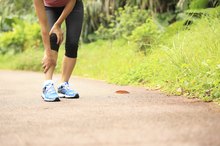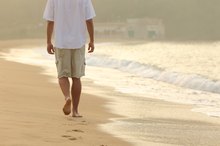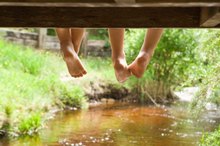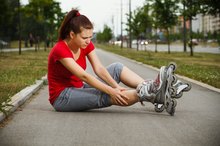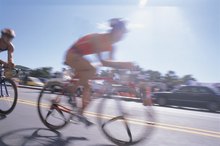Cycling & Thigh Pain
In many cases, feeling thigh pain while cycling is not related to major medical problems. Chafing, cramps and general tiredness in the muscles can all trigger thigh pain. However, you may be able to both prevent future symptoms and find out if your pain is cause for concern. If your thigh pain persists long after your bike ride finishes or causes you excruciating pain, visit a physician immediately.
Chafing
Expert cyclist Sheldon Brown suggests that chafing is one of the most common reasons for thigh pain when cycling. Chafing is when your skin becomes irritated from the friction of rubbing against your clothes or the saddle. On hot, long rides when you're sweating a great deal, chafing tends to get a lot worse. In many cases, chafing results from sitting on a saddle that's too wide or made from padded material, according to Brown. Using Vaseline or a similar petroleum jelly on the thigh can help avoid serious chafing.
- Expert cyclist Sheldon Brown suggests that chafing is one of the most common reasons for thigh pain when cycling.
- In many cases, chafing results from sitting on a saddle that's too wide or made from padded material, according to Brown.
Cramps
What to Do for a Sore Calf From Hiking
Learn More
The thigh is one of the most frequent areas to suffer a muscle cramp when cycling. Cramping is a form of muscle spasm that can cause extreme pain. According to the Cycling Performance Tips website, if you experience a thigh cramp when cycling you should dismount straightaway. Massaging the thigh may be enough to relieve tightness. However, if the cramp is more painful, stretch the area between your hips and upper thighs by doing a lunge stretch. You can stretch light leg cramps while riding, though it's not recommended for beginners.
- The thigh is one of the most frequent areas to suffer a muscle cramp when cycling.
- According to the Cycling Performance Tips website, if you experience a thigh cramp when cycling you should dismount straightaway.
Iliotibial Band Friction Syndrome
Cycling very quickly can trigger iliotibial band friction syndrome, according to the Langone Medical Center at New York University. Your iliotobial band stretches along the outer portion of your thigh. The syndrome is a result of overuse, and in some cases related to riding a bike that's not suited to your frame. The pain symptoms may start in the knee, but often spread up the outer thigh. You may feel a burning or sharp pain when cycling. Treatment includes rest and ice to reduce the damage, often followed by some home-based rehabilitation exercises.
- Cycling very quickly can trigger iliotibial band friction syndrome, according to the Langone Medical Center at New York University.
- The syndrome is a result of overuse, and in some cases related to riding a bike that's not suited to your frame.
Prevention
Nerve, Back & Buttock Pain When Walking
Learn More
Before any cycle ride that's more than just a trip to the local store, make sure to warm up your thigh muscles properly. The University of Maryland Medical Center suggests lifting your foot behind your back toward your buttocks until you feel a stretch in your quadriceps muscles at the front of your thigh. Keep your knee pointing direct to the ground and hold your thigh in place for 10 to 20 seconds. To help prevent cramping, drink plenty of water and avoid cycling in very hot conditions.
- Before any cycle ride that's more than just a trip to the local store, make sure to warm up your thigh muscles properly.
- The University of Maryland Medical Center suggests lifting your foot behind your back toward your buttocks until you feel a stretch in your quadriceps muscles at the front of your thigh.
Related Articles
References
- Harris Cyclery: Bicycling and Pain; Sheldon Brown
- NYU Langone Medical Center: Iliotibial Band Friction Syndrome
- Cycling Performance Tips: Exercise Induced Muscle Pain, Soreness and Cramps
- Koh ZSD, Lin S, Hey HWD. Lumbar disc herniation presenting with contralateral symptoms: a case report. J Spine Surg. 2017;3(1):92-94. doi:10.21037/jss.2017.03.06
- Genevay S, Atlas SJ. Lumbar spinal stenosis. Best Pract Res Clin Rheumatol. 2010;24(2):253-65. doi:10.1016/j.berh.2009.11.001
- Sherry M. Examination and treatment of hamstring related injuries. Sports Health. 2012;4(2):107-14. doi:10.1177/1941738111430197
- Lavine R. Iliotibial band friction syndrome. Curr Rev Musculoskelet Med. 2010;3(1-4):18-22. doi:10.1007/s12178-010-9061-8
- Ryan AS, Buscemi A, Forrester L, Hafer-macko CE, Ivey FM. Atrophy and intramuscular fat in specific muscles of the thigh: associated weakness and hyperinsulinemia in stroke survivors. Neurorehabil Neural Repair. 2011;25(9):865-72. doi:10.1177/1545968311408920
- Centers for Disease Control and Prevention. Understanding Blood Clots. Updated March 14, 2019.
- Cherkin DC, Sherman KJ, Avins AL, et al. A randomized trial comparing acupuncture, simulated acupuncture, and usual care for chronic low back pain. Arch Intern Med. 2009;169(9):858-66. doi:10.1001/archinternmed.2009.65
- Lempainen L. Operative treatment for the painful posterior thigh after hamstring autograft harvesting. Muscles, Ligaments and Tendons Journal. 2017;7(3):570. doi:10.11138/mltj/2017.7.3.570
Writer Bio
Based near London, U.K., Peter Mitchell has been a journalist and copywriter for over eight years. Credits include stories for "The Guardian" and the BBC. Mitchell is an experienced player and coach for basketball and soccer teams, and has written articles on nutrition, health and fitness. He has a First Class Bachelor of Arts (Hons.) from Bristol University.
